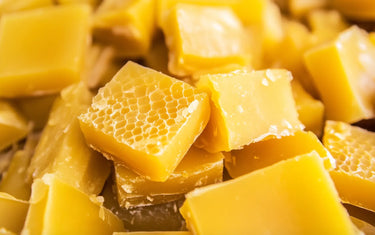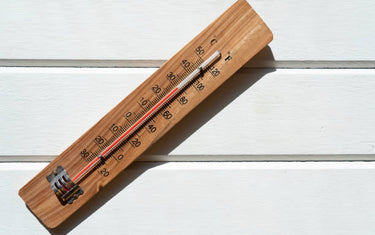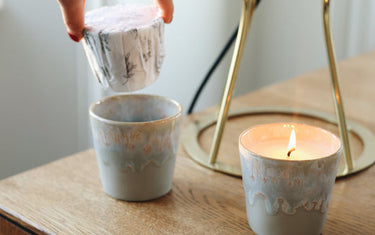4 min read / 6 June 2023 / Laura Garvin Gomez
How do Wax Melts Work?
Unravel the science and mechanics behind wax melts' enchanting fragrance diffusion in a comprehensive exploration that will ignite your curiosity.
Share this post

If you are new to wax melts, and are not sure how they work or what they can be used for, we’ve put together a short guide to tell you everything you need to know.
The clue to how they work is in what they are called, and you do not need any complicated equipment to get started. Here, we explain how to get the most out of your wax melts so you can transform any room in your home with the fragrance of your choice.
What is a wax melt?Wax melts are essentially wickless candles that have been scented with essential oils or fragrance oils. Instead of lighting a wick, the wax itself is melted via a warmer (tea light or electric), allowing the scent to be released into the air. Melting the wax offers an efficient alternative, as it is done at a constant temperature, so the aroma can vaporise at a steady pace in the room. |
What are wax melts used for?
Wax melts are used for different reasons, depending on the space and person wanting to enjoy them. Because they release fragrances into the air, they can simply be used to add a refreshing scent to the room to change the mood, whether it is to heighten the existing feeling or create something different.
When essential oils are included in a wax melt recipe, it also allows people to try out the aromatherapy benefits offered by the oils. For example, a melt with lavender oil can make the room feel more relaxed so it is easier to drift off to sleep, or lemongrass oil could help to boost your mood and help set a more positive environment.

How do wax melts work?
Wax melts are very easy to use, and below we explain more about how they function:
- Melting the wax: When you light a candle, the heat from the wick melts the wax as it burns, releasing the aroma into the air. This is similar to a wax melt, although the heat source is set underneath the melt, which is placed onto a melting tray, and it slowly melts and releases its fragrance.
- Wax melt safety: If you want to reduce the risk of house fire when burning candles, using an electric warmer is a safer option, as a flame is not a necessity to burn the melt. Instead, when using an electric warmer, a lightbulb gently melts the wax and can be switched off when you leave the room or go to bed.
- Scent control: Melting wax gives you more control over the aroma being released in the room, which can be helpful in smaller spaces. You decide how much wax will be melted at any one time, so you can also vary the scent more frequently and combine them with other melts at the same time.
Learn more about how wax melts work.
How do you use wax melts?
If you are wondering, “What do you do with wax melts?” and how do you use them, follow the steps below to get started:
- Make or buy your wax melt: Making your own wax melts is easy, requiring only a few simple and affordable ingredients. Alternatively, there are plenty of places to buy them online, with lots of fragrance options to suit your personal tastes.
- Add to the wax warmer: Most melting trays allow space for 1-2 wax melts, so place your preferred quantity onto the tray for melting.
- Turn on the warmer: An electric warmer can be switched on using a switch or button, whilst a tea light warmer requires you to place a lit tea light below the tray.
- Clean the burner: Once the wax melt has finished and is no longer producing enough scent, it’s time to switch to another. Wait for the warmer to cool to the touch, scoop out the hardened wax and dispose. Then clean the warmer using warm, soapy water and allow it to air dry before reusing.
And that is all you need to know when it comes to using wax melts. Once the wax starts to melt and release its perfume into the room, it can last for hours on end, depending on the size of the melt and airflow in the room.

How are max welts different from candles?
Aside from there being no wick in a wax melt, the main difference compared to candles is that you have more room for creativity.
Of course, you can make your own candles at home using essential oils, blending different fragrances for something unique, but the shape and style is usually fixed into a certain mould as the wick needs to burn downwards.
With a wax melt, you can buy a wide range of moulds allowing them to be shaped into almost any design. So, whether they are for personal use, being given away as gifts, or even sold online as part of a business, you can be as experimental as you want.
Another important difference is that wax melts are a safe option as there is no flame involved (if you are using an electric warmer). Wax melts do not emit smoke, so the fragrance isn’t affected, and it won’t interfere with any smoke alarms you may have installed.

Wax melts give you a fun and easy alternative to candles, which is good news for anyone with children or pets running around. If you want to take the next step and make your own, you can also include fragrance oils in the recipe, giving you even more aromatic options to enjoy. From the living room and kitchen to the bathroom and bedrooms, wax melts fit in almost anywhere, giving you an easy way to scent your home however you want to.










